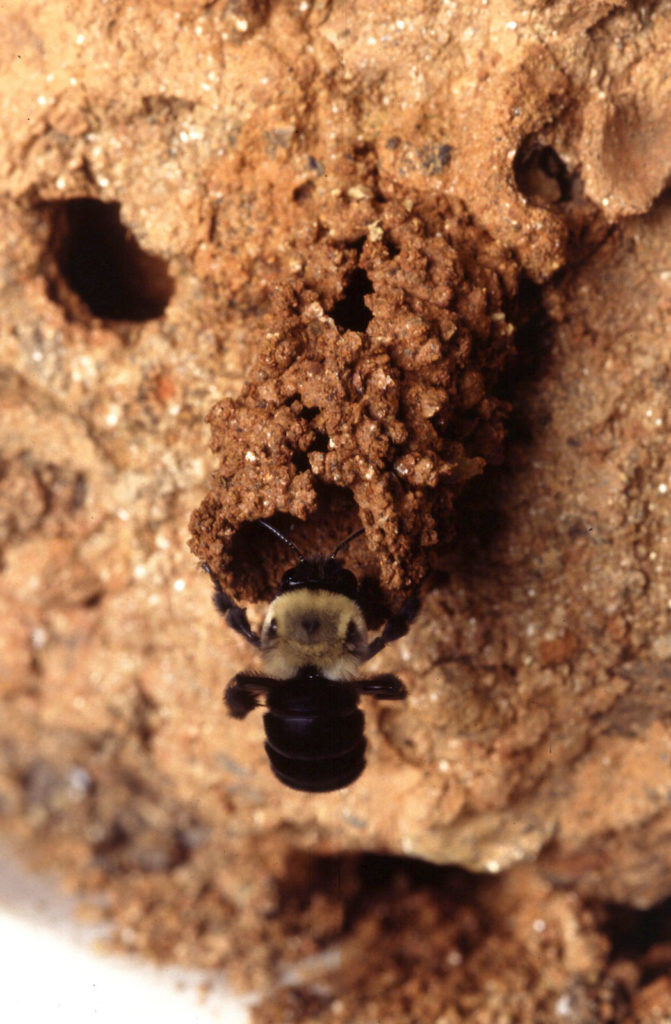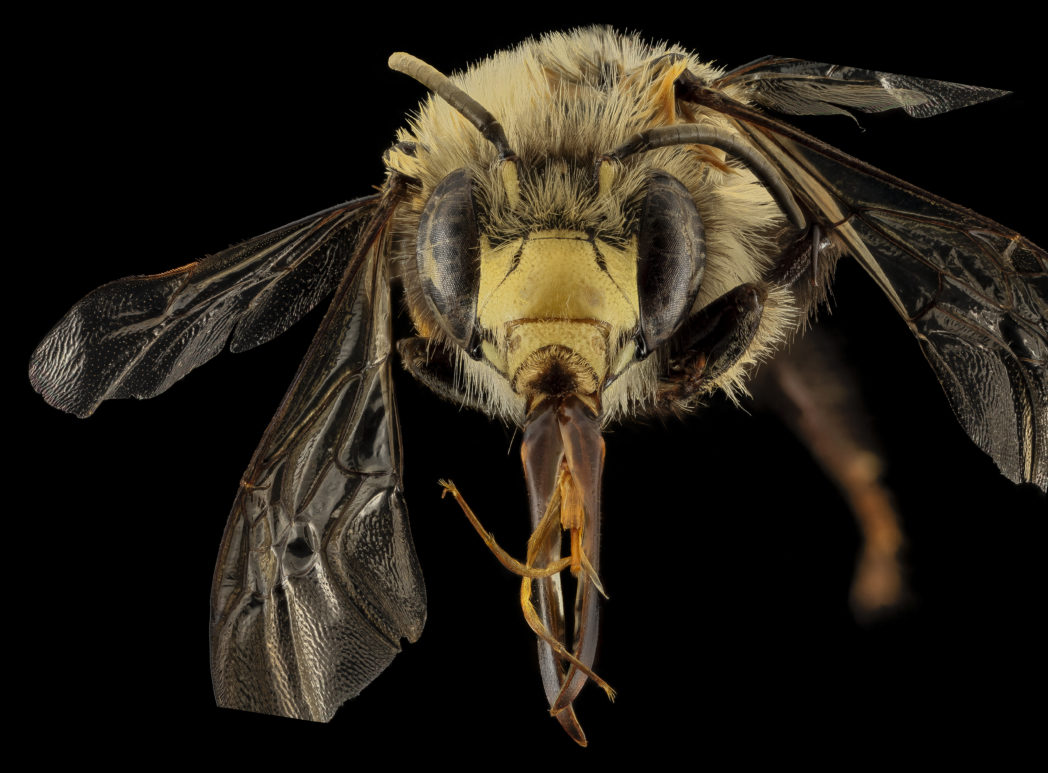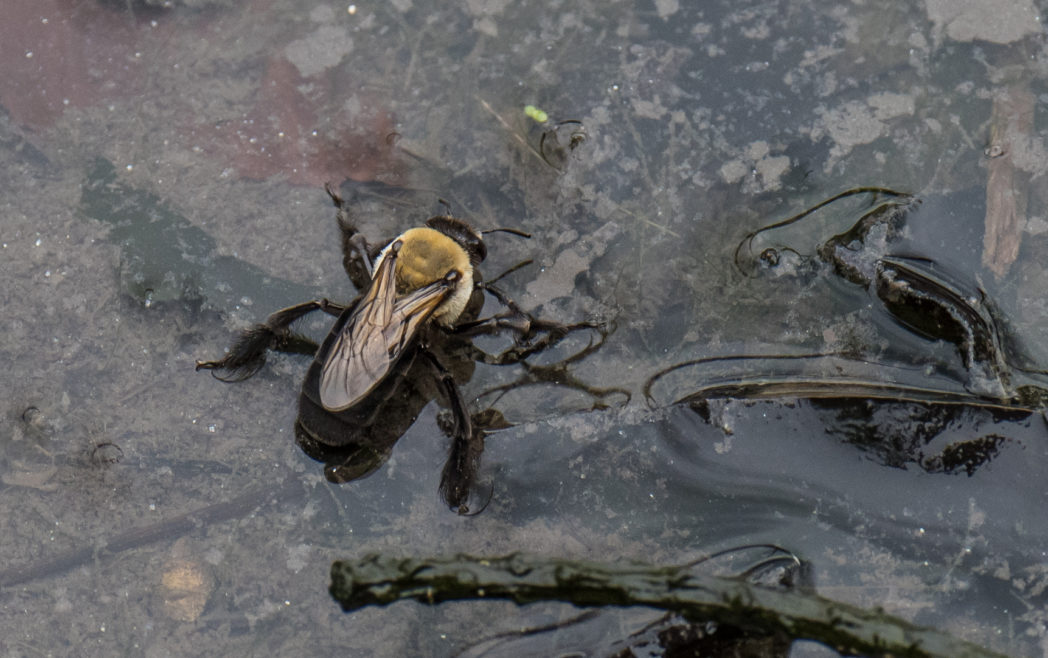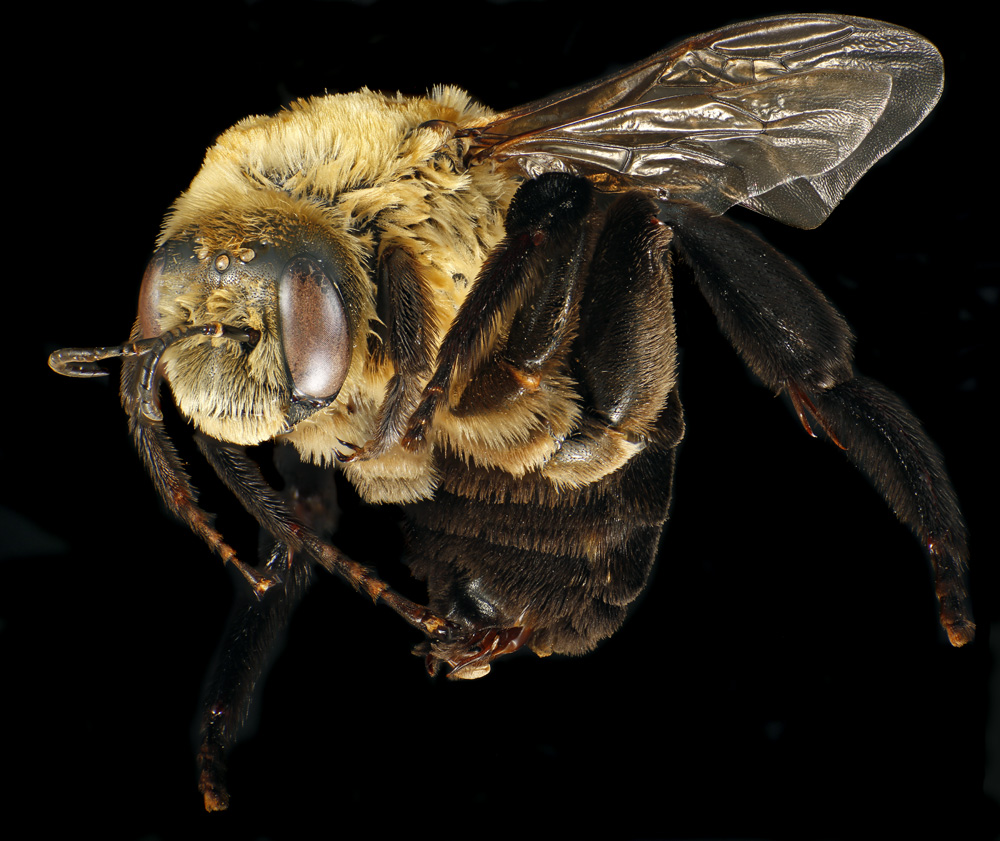Chimney bees
by Jonnie Dietz, Florida Museum of Natural History
“Know your native pollinators” is a series of articles that will help you identify and appreciate Florida’s varied pollinators, including bees, wasps, butterflies, moths, beetles, flies, birds and bats. Pictured above: Hibiscus bee (Ptilothrix bombiformis) by Jonathan Bremer.
Chimney bees, such as Mustached mud and Hibiscus bees, are solitary ground nesters that have serious architectural talent!
CLASSIFICATION
Class: Insecta
Order: Hymenoptera
Family: Apidae
Subfamily: Apinae
FORAGING PREFERENCES
Mustached mud bees (Anthophora abrupta) forage on a wide variety of plants, some of which include flowers in the following genera and families:
- Beardtongues (Penstemon spp.)
- Evening primrose (Oenothera spp.)
- Sunflower family (Asteraceae)
- Legume family (Fabaceae)
- Rose family (Rosaceae)
- Nightshade family (Solanaceae)
Hibiscus bees (Ptilothrix bombiformis) are specialists and forage on:
- Hibiscus spp.
IDENTIFICATION
Both the Mustached mud bee and Hibiscus bee superficially resemble bumblebees in appearance. They’re fast flying, robust bees with dense yellow hairs on their thorax. (Hibiscus bees also have yellow hairs on their face.)
A Bee by Any Other Name…
Many bee species (or groups of bees) acquire a variety of common names based on their behavior or even the region in which they occur. Since the two species featured here are ground nesters, they’re sometimes referred to as miner bees or digger bees. But both the Mustached mud and Hibiscus bees construct diagnostic, chimney-like turrets around their nest entrances, earning them yet another, more distinctive common name: Chimney bees.
Mustached mud bee (Anthophora abrupta)
Mustached mud bees occur along the East Coast from Canada to Florida, and west to Texas. They emerge in spring and fly through the summer, but live underground in their nests for the remainder of the year. These bees will forage on an extremely wide variety of flowers and are considered important pollinators of cranberries.
Mating also takes place on flowers. Although females likely mate only once, males will seek out multiple partners. Once mated, females fly in a zig-zag motion above the ground looking for suitable cracks and holes (usually in clay or clay banks) to begin excavating their nest. These are solitary bees (meaning every female builds her own nest and provides for her own young), but they often nest in large aggregations.
Once a female finds a suitable spot, she softens the ground with water and begins digging. Excavated soil is first used to sculpt a chimney-like turret around the entrance. Each turret takes about six hours to complete and averages over 3 inches in length! The true purpose of these chimneys is still unknown, but they could function as solar heaters, protection from rain, wind or parasites, or even as nest recognition structures. Once the chimney is complete, the female constructs and provisions multiple nest cells with bee bread (a ball of pollen and nectar) and lays a single egg on top. The nest entrance is sealed shut, and her offspring will emerge the following spring.

A female Mustached mud bee (Anthophora abrupta) hovers by the chimney-like entrance of her nest. Photo courtesy of Scott Bauer, U.S. Department of Agriculture (CC BY 2.0)

Can you see the hairy “mustache” on this male Mustached mud bee (Anthophora abrupta)? Photo courtesy of USGS Native Bee Inventory and Monitoring Laboratory.

Hibiscus bee (Ptilothrix bombiformis) collecting water to soften the soil at her nest site. Photo © Richard Orr (used with permission).
Hibiscus bee (Ptilothrix bombiformis)
The Hibiscus bee (Ptilothrix bombiformis) is a species of chimney bee found throughout the eastern United States. In Florida, these summer bees fly from June to September, and as their name suggests, they forage primarily on hibiscus flowers.
Similar to the Mustached mud bees, Hibiscus bees have mad chimney-sculpting skills. Females dig nests in hard packed soils (usually near a water source) and use water to moisten the ground, making excavation a little easier. Water collection takes multiple trips, and these ladies will actually alight on the water’s surface to collect water with their proboscis (tongue)!
As the female excavates her nest, she builds a chimney-like turret around the entrance. She digs straight down into the ground where she constructs one to a few nest cells, and lines each chamber with a waterproof substance secreted from a special gland. Each cell is stocked with a ball of pollen and nectar on which she lays a single egg.
References:
- Batra, S. “Cranberry-Pollinating Bee Wears a Mustache,” USDA Agricultural Research Magazine, Vol. 46, No. 9, Sept. 1998. agresearchmag.ars.usda.gov/1998/sep/poll [Accessed 17 Jun. 2018]
- The Bees of Florida. John B. Pascarella, PhD, Dean of the College of Sciences, Professor of Biological Sciences, Sam Houston State University, Huntsville, Texas. http://entnemdept.ufl.edu/HallG/Melitto/Intro.htm
- Graham, Jason, Jamie Ellis, Glenn Hall, and Catherine Zettel Nalen. “Miner Bee, Chimney Bee Anthophora abrupta Say,” Entomology and Nematology Department, Cooperative Extension Service, Institute of Food and Agricultural Sciences, University of Florida, Gainesville, FL., 2011. http://edis.ifas.ufl.edu/in912
- Michener, Charles D. The Bees of the World. Baltimore: Johns Hopkins U Press, 2010. Print.
- Mitchell, Theodore B. Bees of the Eastern United States, Volume 2. Raleigh, NC: Published by the North Carolina Agricultural Experiment Station with Support from the National Science Foundation, 1962. Print.
- Rust, Richard W. “The Biology of Ptilothrix Bombiformis (Hymenoptera: Anthophoridae).” Journal of the Kansas Entomological Society, Vol. 53, No. 2, 1980, pp. 427–436. JSTOR, JSTOR, www.jstor.org/stable/25084048.
- Simpson, Melissa. “Ptilothrix Bombiformis, the Rose-Mallow Bee.” US Forest Service. www.fs.fed.us/wildflowers/pollinators/pollinator-of-the-month/rosemallowbee.shtml.
- Wilson, Joseph S., and Olivia Messinger Carril. The bees in your backyard: a guide to North America’s bees. Princeton: Princeton U Press, 2016. Print.

